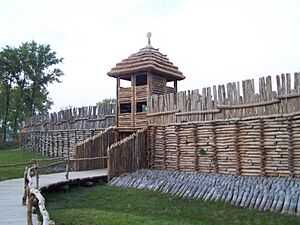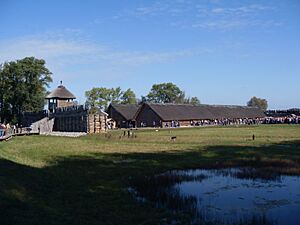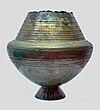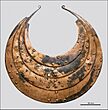Lusatian culture facts for kids

Lusatian culture's furthest extent (green)
|
|
| Alternative names | Lausitz culture |
|---|---|
| Geographical range | Central Europe |
| Period | Late Bronze Age to early Iron Age |
| Dates | c. 1200–500 BC |
| Preceded by | Trzciniec culture, Tumulus culture, Nordic Bronze Age, Urnfield culture |
| Followed by | Pomeranian culture, Cimmerians |
The Lusatian culture was a group of people who lived in Central Europe a very long time ago. They existed during the late Bronze Age and the early Iron Age. This means they lived from about 1300 to 500 BC.
Their lands covered most of what is now Poland. They also lived in parts of the Czech Republic, Slovakia, eastern Germany, and western Ukraine. The Lusatian culture was connected to other ancient groups, like the Nordic Bronze Age people. They also shared some ideas with the Hallstatt culture, especially in their jewelry and weapons.
How the Lusatian Culture Began

The Lusatian culture grew out of an older group called the Trzciniec culture. They were also influenced by the Tumulus culture from the Middle Bronze Age. This helped them become part of the larger network of Iron Age Europe.
They were also part of the Urnfield system. This system included groups that later became the Celts and Romans. The Urnfield system stretched from eastern France to Hungary.
In Poland, the Lusatian culture lasted into the Iron Age. Later, a new group called the Pomeranian culture took over in the northern areas.
A German scientist named Rudolf Virchow first studied the burials of the 'Lusatian-type'. The name "Lusatian" comes from the Lusatia area in eastern Germany and western Poland. Virchow found their pottery but didn't know what ethnic group made them.
A Polish archaeologist, Józef Kostrzewski, started digging at a Lusatian settlement called Biskupin in 1934. He thought the Lusatian culture might have been ancestors of the early Slavs. Today, most archaeologists believe we don't know the exact language or ethnic group of these ancient people.
Daily Life and Culture
The Lusatian people usually burned their dead. This is called cremation. They would place the ashes in an urn. Often, many other small pots (sometimes up to 40!) were buried with the urn.
They didn't put many metal gifts in graves. However, they had many hidden collections of valuable items, called hoards. These hoards contained beautiful metalwork, including bronze and gold. One famous gold hoard was found in Eberswalde, Germany.
Some graves had molds and tools for making bronze items. This shows that people made bronze tools and weapons right in their villages. A very special tomb, called the 'royal' tomb of Seddin in Germany, was covered by a large mound of earth. It contained fancy items from far away, like bronze pots and glass beads. Some cemeteries were huge, with thousands of graves.
Well-known Lusatian settlements include Biskupin in Poland and Buch near Berlin. Some villages were open, while others were fortified. These fortified settlements were like small forts, built on hilltops or in swampy areas. Their walls were made of wooden boxes filled with soil or stones. These forts are sometimes called burgwalls or gords.
Farming and Food
The Lusatian people were mostly farmers. They grew a lot of crops, as shown by the many storage pits they used. Their main crops were wheat (a type called emmer) and six-row barley. They also grew millet, rye, oats, peas, broad beans, lentils, and a plant called gold of pleasure. They also grew Flax to make cloth. They ate domesticated apples, pears, and plums.
For meat, they mainly raised Cattle and pigs. They also kept sheep, goats, horses, and dogs. Pictures on Iron Age urns show people riding horses. Horses were also used to pull chariots.
Hunting was also part of their lives. They hunted animals like red and roe deer, boar, bison, elk, hare, fox, and wolf. However, hunting didn't provide most of their food. Interestingly, many frog bones were found at Biskupin, which might mean they ate frogs' legs!
Gallery
-
Socketed axes and arm rings
-
Fibula and arm rings
-
Bronze arm rings, Germany
-
Bronze arm bands
-
Bronze tableware, 1200–1000 BC, Dresden, Germany
See also
- Lusatia
- Urnfield culture
- Nordic Bronze Age
- Hallstatt culture
- Schweinert burial mounds
- Heidenschanze fortified settlement


























